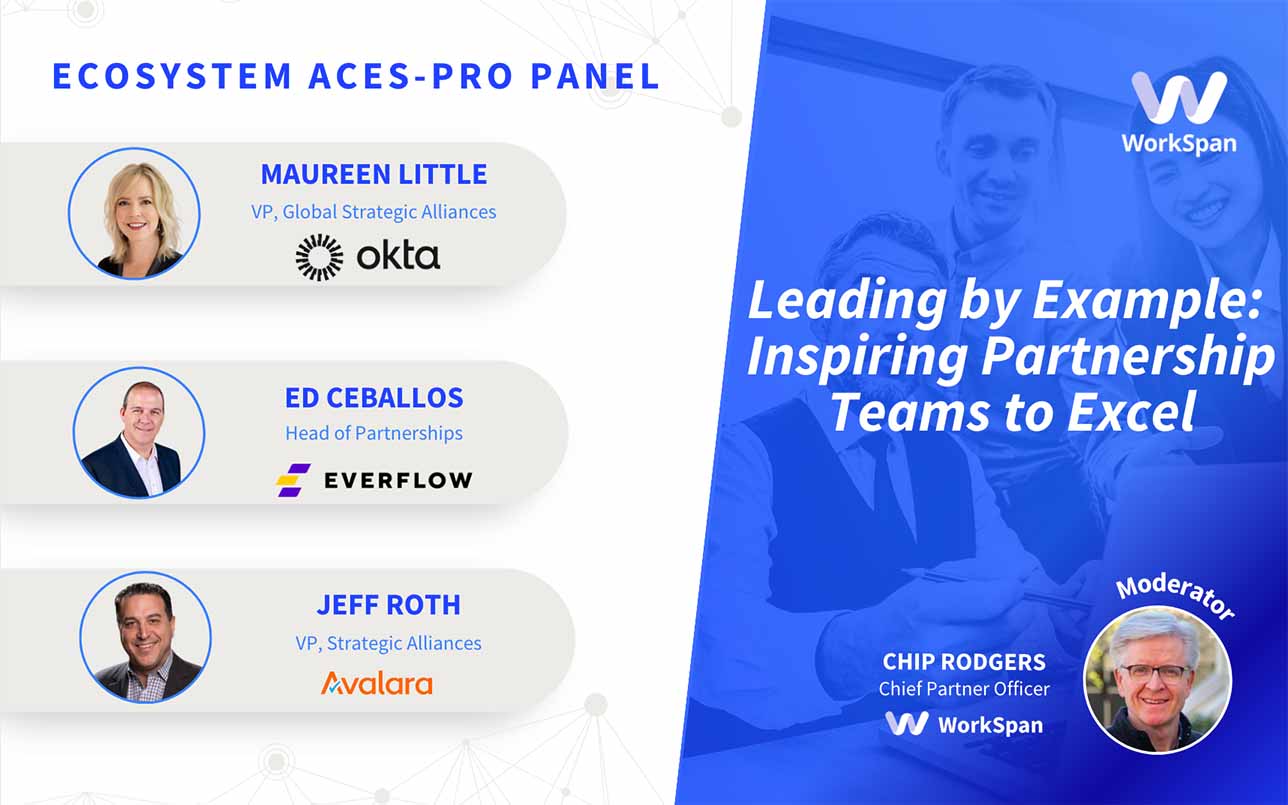
In yet another engaging episode of Ecosystem Aces Pro Panel discussion, WorkSpan brought together a group of powerhouse partner leaders. This time the spotlight was on the compelling topic “Leading by Example: Inspiring Partnership Teams to Excel”.
The pro panelists shared their insights and practical advice offering valuable strategies to inspire and elevate partnership teams in their endeavors.
Our panelists:
- Maureen Little, VP, Global Strategic Alliances, Okta
- Ed Ceballos, Head of Partnerships, Everflow
- Jeff Roth, VP Strategic Alliances, Avalara
The discussion kicked-off with understanding what it takes to be a leader in a partner focused organization.
Important qualities of a leader that can inspire partnership teams to excel
The panelists stressed on the need for aligning internal teams and external partners on key areas of partnership..
- Clarity and Communication: Leaders in partnership teams must provide clarity to their teams about the company's goals and how their efforts contribute to the larger picture. Clear communication is essential in aligning everyone with the organization's objectives.
- Balancing Delegation and Hands-On Approach: Effective leaders strike a balance between delegating tasks and getting directly involved in certain aspects. They establish clear guidelines for tasks that can be handled autonomously by team members and those that require their approval or intervention.
- Cross-Functional Collaboration: Partnership leaders facilitate collaboration between various teams within the organization, such as product, marketing, and sales. Educating different teams about the importance of partnerships and their impact fosters a cohesive work environment.
- Encouraging Innovation: Leaders should encourage their teams to experiment and innovate within controlled environments. Allowing team members to explore new ideas and approaches can lead to valuable insights and improvements in partnership strategies.
- External Communication: Leaders ensure that the value of partnership efforts is recognized not only within the team but also across the entire organization. They advocate for their team's initiatives to top-level executives, including the CFO and CEO, ensuring that partnerships are integrated into the company's overall business strategy.
How can leaders overcome challenges when leading partnership teams
In high-growth companies, managing partnerships presents ongoing challenges. The continuous rise in quotas demands rapid adaptation from team members. Clarity and effective communication are paramount, ensuring everyone comprehends the purpose behind their tasks.
Controlling the partner experience post-sale, especially with customer-facing teams involved, adds complexity, impacting the quality of the experience. Balancing core responsibilities with extra projects further complicates partnership management, highlighting the intricacies within a dynamic business landscape.
Integrating partners seamlessly into the entire sales lifecycle is a significant hurdle. Recognizing the pivotal role of partners in increasing the pipeline, reducing sales costs, and ensuring retention is crucial. Collaborating effectively with customer service organizations to align partner involvement with renewal processes is challenging and demands strategic initiatives.
The need to involve partners earlier in the renewal process is essential for positive outcomes. Additionally, measuring the value of partner contributions beyond deal closures requires accurate data and understanding across the organization, even at the CFO level.
Partner retention and expansion pose significant challenges, particularly in the context of tech partners. While alignment in co-marketing and co-selling initiatives occurs during the initial phase, maintaining partnerships beyond the lead phase is challenging. Often, partnership efforts diminish after the lead is secured, leading to a lack of focus on customer retention.
Aligning teams and incentives for post-landing engagement, integration adoption, and activation proves difficult. Adopting a holistic approach to the customer lifecycle is crucial, necessitating the establishment of long-term engagement and growth strategies. Successfully incentivizing counterparts in customer sales organizations to actively participate in these efforts requires aligning teams for effective partnership outcomes.
Overcome attribution challenges, recognize partners' value in pipeline and initiatives
In today's intricate business landscape, accurately measuring the impact of partnerships on sales pipelines has become a crucial yet complex endeavor. Drawing insights from industry experts and real-world examples, businesses can navigate these challenges effectively.
Maureen Little emphasized the significance of incorporating Customer Success insights. These teams, armed with in-depth knowledge of client relationships, provide invaluable perspectives for precise partner attribution.
A prime example of successful partner management is Avalara, where aligning sales teams with partners is paramount. By understanding partners' unique client relationships and integrating their efforts seamlessly, Avalara maximizes the value partners bring to the table.
Furthermore, Avalara always attempts to strike a balance between short-term gains and long-term benefits, prioritizing enduring partnerships over immediate revenue. Leveraging advanced technology, Avalara tracks partner contributions meticulously, enabling data-driven decisions and enhancing collaboration strategies.

In conclusion, businesses can overcome partner attribution challenges by fostering effective alignment, incorporating Customer Success insights, and utilizing technology. These strategies empower companies to build enduring partnerships, drive sales success, and navigate the complex landscape of modern business.
What are some good examples of metrics to measure Lifetime Value (LTV) of a partner relationship? (Audience question: from Justin Soderquist, Bamboo HR )
In response to the question about metrics to measure the lifetime value (LTV) of a partner relationship, the panelists emphasized the significance of tracking joint client relationships and their impact on lifetime value (LTV) and the recurring revenue (ARR/MRR).
They also mentioned other key metrics such as the number of partner-led projects, training attendance, co-marketing activities, and the percentage of partners engaged in referring and closing deals. These metrics provide a comprehensive overview of the effectiveness of partner collaborations, showcasing the diverse factors considered when evaluating the success of partner relationships.
Are there concurrent partnership trends with General AI's prominence
The panelists highlighted the significant impact of AI and machine learning in the business landscape, emphasizing the importance of leveraging data and ensuring the rights to use it when integrating AI into products. They pointed out the evolving nature of AI applications, from transactional functions to owning entire processes, leading to fundamental transformations in various sectors.
Despite the growing role of AI, the human factor remains crucial, especially in partnerships, where relationships and trust play a pivotal role. As AI technologies advance, human qualities, peer recommendations, and the ability to maintain genuine connections become even more vital, underscoring the enduring importance of human interactions in the face of technological advancements.
Conclusion
Successful partnerships rely on clear communication, strategic integration, and holistic retention efforts. Effective leaders prioritize transparent team communication, seamless partner integration, and early involvement in renewal processes. Metrics such as joint client relationships, partner-led projects, and co-marketing activities provide valuable insights.
Links & Resources
- Learn more about how WorkSpan helps customers accelerate their ecosystem flywheel through Co-selling, Co-innovating, Co-investing, and Co-marketing.
- Subscribe to the Ecosystem Aces Podcast on Apple Podcast, Spotify, Stitcher, and Google Podcast.
- Find insightful articles on leading and getting the most out of your partner ecosystem on the WorkSpan blog.
- Download the Best Practices Guide for Ecosystem Business Management
- Download the Ultimate Guide for Partner Incentives and Market Development Funds
- To contact the host, Chip Rodgers, with topic ideas, suggest a guest, or join the conversation about modern partnering, he can be reached on Twitter, LinkedIn, or send Chip an email at: chip@workspan.com
Heading
Heading 1
Heading 2
Heading 3
Heading 4
Heading 5
Heading 6
Lorem ipsum dolor sit amet, consectetur adipiscing elit, sed do eiusmod tempor incididunt ut labore et dolore magna aliqua. Ut enim ad minim veniam, quis nostrud exercitation ullamco laboris nisi ut aliquip ex ea commodo consequat. Duis aute irure dolor in reprehenderit in voluptate velit esse cillum dolore eu fugiat nulla pariatur.
Block quote
Ordered list
- Item 1
- Item 2
- Item 3
Unordered list
- Item A
- Item B
- Item C
Bold text
Emphasis
Superscript
Subscript





.png)